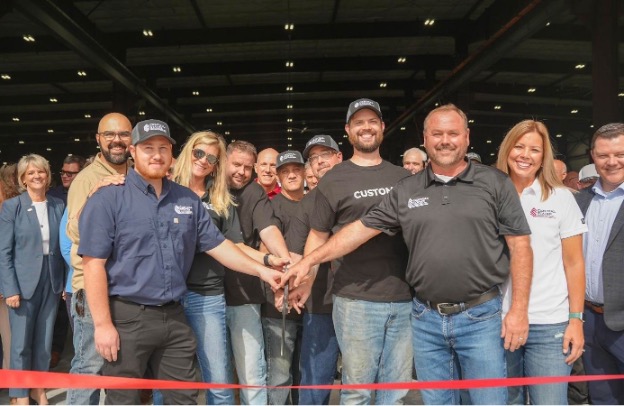Building Together: 4 Things Utah Elected Officials Should Know About Economic Development

August 29, 2024
EDCUtah’s Development Ready Communities (DRC) training program includes a primer on economic development for Utah elected officials at the city and county levels. Greg Bisping, EDCUtah vice president of community strategy, moderated a recent session. He was joined by a diverse group of presenters from EDCUtah’s investor community:
- Brad Simons, Enbridge (formerly Dominion Energy)
- Jason Burningham, LRB Public Finance Advisors
- Ginger Chinn, Salt Lake Chamber
- Jen Wakeland, Beaver County
- Paul Larsen, Brigham City
- Ben Hart, Utah Inland Port Authority
- Marcia White, Wasatch Front Regional Council (WFRC)
The training covers many topics in detail—but here are four things elected officials should know about economic development in Utah.
1. Understanding State and Municipal Goals
One key concept discussed in the training is the balance between the goals and methods of economic development at the state and local levels. Understanding that relationship allows all community leaders to better leverage their own roles and the roles of other stakeholders.
Paul Larsen, community and economic development director of Brigham City, explained that relationship this way: “We all have the goal to grow, diversify, and improve economic and social conditions in our state and communities. How we get there can differ. The State prioritizes corporate growth and high-paying jobs that contribute to income tax. That drives the focus of their efforts and how they structure their incentive programs.”
When it comes to local government, the tools and targets change, Larsen said. “Sales and property taxes are the main sources of revenue for municipal governments. High-paying jobs are great for a community’s quality of life, but those jobs are not necessarily a boost for city budgets.”
Local governments often need support recruiting and retaining local retail and other small businesses. Jen Wakeland, strategic development director for Beaver County, emphasized the value of collaborating across jurisdictions.
“I take a holistic approach. A win for Milford City is going to have a positive impact on Beaver City and vice-versa,” Wakeland said. “The County’s role is to make connections with all of our stakeholders, to work out ahead of time what our economic development priorities are. Economic development is best served by partnership and collaboration between cities and counties. It’s not a competition.”
2. Review and Update Your Community’s Economic Development Plan
Marcia White, the regional economic development planner for the Wasatch Front Regional Council (WFRC), emphasized the critical need for a comprehensive economic development plan. As one of the seven associations of governments (AOGs) in Utah, WFRC plays a pivotal role in shaping the state’s economic future by crafting a regional Comprehensive Economic Development Strategy (CEDS) every five years.
This strategy is a key component of Utah’s broader economic opportunity ecosystem, designed to support local cities and counties in their economic development initiatives. White highlighted that WFRC, along with other AOGs across the state, serves as a valuable resource for communities as they develop or update their economic plans.
White also underscored the importance of coordination among regions and communities to maximize the effectiveness of economic development efforts. With Utah's continued growth, aligning infrastructure investments, development patterns, economic development site selection, and job opportunities is essential for creating vibrant, economically thriving communities where quality of life remains high.
Other speakers stressed that community-level plans should align and support a given city or county’s general plan. Brigham City’s Paul Larsen stated that general plans should include an economic development component, and that economic development efforts should be considered an implementation strategy for the general plan.
3. Get to Know Your Financing Toolbox
Jason Burningham, principal and owner of LRB Public Finance Advisors, and Ben Hart, executive director of the Utah Inland Port Authority, spoke about the use of tax increment financing (TIFs), Community Reinvestment Agencies (CRAs), Redevelopment Agencies (RDAs), and associated Public Infrastructure Districts (PIDs).
The general discussion focused on managing the pros and cons of TIFs. Burningham and Hart both noted that TIFs are useful for improving public infrastructure, something that companies find attractive when considering an expansion in Utah.
While TIFs can attract new businesses, they can also cut into city revenue. “There’s only so much property tax to go around,” one speaker noted. TIFs often require a considerable amount of discussion and negotiations with all stakeholders, such as schools and other districts. The Port Authority offers communities a distinct advantage in that it negotiates with all stakeholders in developing a TIF. “This is more efficient, and it can take local officials off the hot seat,” Hart said.
Hart also noted that the Port Authority, which has 11 project areas currently around the state, doesn’t dictate strategy. “We try to support the long-term goals of local communities. We look for communities that are ready and willing to focus on logistics projects.”
Burningham stressed that all incentives should be performance-based. Echoing the discussion about planning, he said that a good plan puts in place policies that can help communities make incentive decisions in a consistent, transparent, and effective manner.
4. Leverage the Expertise of Business & Utility Partners
Rounding out the session were Brad Simons, gas development services consultant for Enbridge (formerly Dominion Energy), and Ginger Chinn, executive vice president of public policy & government affairs for the Salt Lake Chamber.
Simons highlighted the valuable resources available to municipal leaders through infrastructure partners. “Infrastructure – whether it be gas, electrical, water, internet, and more – can be complicated,” Simons said. “Your partners are ready to answer questions and discuss project timelines, so please reach out.”
Chinn introduced some of the statewide initiatives and organizations available through the Salt Lake Chamber, including legislative policy efforts and the Women’s Business Center of Utah. “The Chamber is a statewide organization, and we have members from all 29 counties in Utah. Please let us know what issues you face, so we can better represent the needs of your business communities to Utah’s Legislature and executive branch,” she said.
A recording of the elected officials training is available by request for EDCUtah investor communities. We encourage you to share this article, or the recorded training, with the elected officials in your community. Want to learn more about these and other EDCUtah community investor resources? Contact us at connect@edcutah.org.
“Building Together” highlights examples of the collective impact of your investment and EDCUtah’s work in communities across the state. Do you have a story you’d like us to share? Email connect@edcutah.org.







